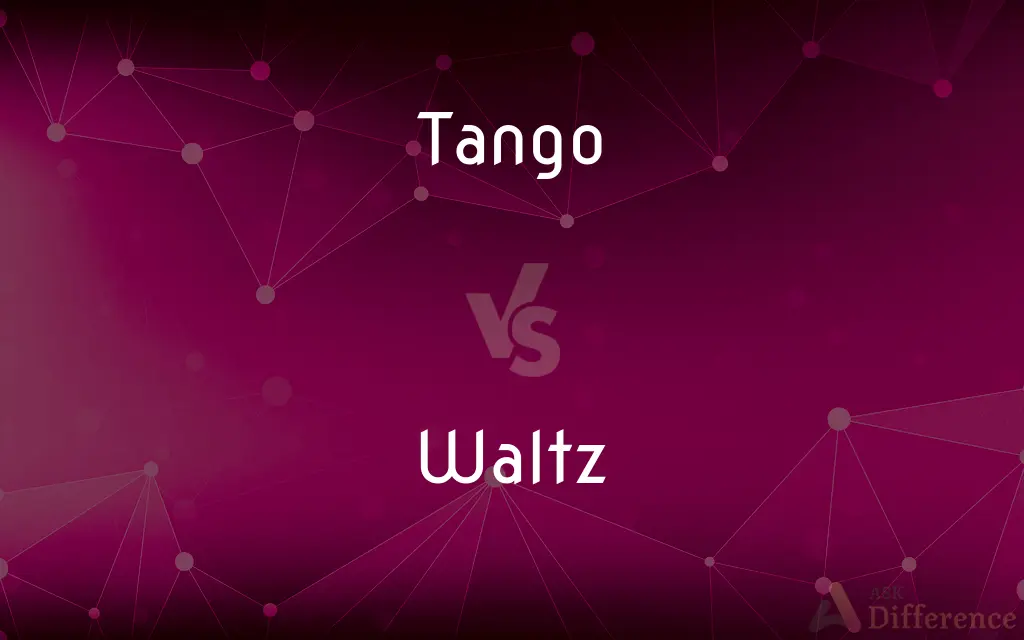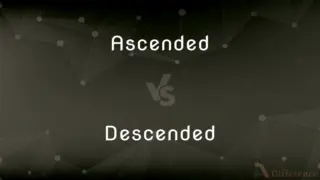Tango vs. Waltz — What's the Difference?
By Urooj Arif & Fiza Rafique — Updated on April 15, 2024
Tango features dramatic, sharp movements and a close embrace, focusing on improvisation; Waltz is characterized by its flowing, smooth steps and a rise-and-fall motion, emphasizing grace.

Difference Between Tango and Waltz
Table of Contents
ADVERTISEMENT
Key Differences
Tango is primarily known for its passionate, staccato movements and a distinctive close embrace that intensifies the connection between partners, whereas Waltz is celebrated for its graceful, flowing movements and a more structured form of dance that emphasizes elegance.
In Tango, dancers often perform to the music with dramatic pauses and improvisational steps, highlighting individual expression within the dance, while Waltz maintains a consistent tempo with rhythmic timing, providing a continuous, smooth dance experience.
The music for Tango typically features complex rhythms and can vary widely in tempo, supporting the dramatic and spontaneous style of the dance; on the other hand, Waltz music is characterized by its strong, regular beat, usually in triple time, which supports the fluid and rhythmic dance steps.
Tango originated in the late 19th century in the working-class neighborhoods of Buenos Aires, reflecting the cultural melting pot of Argentina, whereas Waltz developed in Western Europe, particularly Austria and Germany, as a dance of the courts and high society.
The attire for Tango often includes dramatic and sensual outfits that enhance the expressive movements of the dancers, whereas Waltz attire tends to be more formal and traditional, mirroring the elegance and structured nature of the dance.
ADVERTISEMENT
Comparison Chart
Origin
Buenos Aires, Argentina (late 19th century)
Western Europe (18th century)
Music Rhythm
Complex, varying tempos
Strong, regular, usually in triple time
Dance Style
Improvisational, dramatic
Structured, smooth
Typical Movement
Sharp, staccato, close embrace
Flowing, rise-and-fall, elegant
Cultural Context
Working-class neighborhoods
Courts and high society
Compare with Definitions
Tango
An act or instance of dancing the tango.
Their tango at the wedding was beautifully executed.
Waltz
To move or glide in a lively or conspicuous manner (informal).
He waltzed into the room with an air of confidence.
Tango
A passionate ballroom dance originally from Argentina, characterized by sharp movements and a close embrace.
The couple's tango captivated everyone with its intensity.
Waltz
A ballroom dance in triple time with a strong accent on the first beat, known for its flowing movements.
They took the floor for a classic waltz.
Tango
Music specifically composed for or resembling the rhythm and style of the tango dance.
The band played a tango that filled the room with energy.
Waltz
To complete something easily or effortlessly (informal).
He waltzed through the exam without studying much.
Tango
A code word representing the letter 'T' in the NATO phonetic alphabet.
The pilot spelled out the coordinates, starting with Tango.
Waltz
An act of dancing the waltz at a social event.
Their first waltz as a married couple was magical.
Tango
A metaphor for a complex, intertwined interaction.
Negotiating this deal is a delicate tango of interests.
Waltz
Music composed for dancing the waltz, typically having a 3/4 rhythm.
The orchestra played a waltz that reminded her of Vienna.
Tango
Tango is a partner dance, and social dance that originated in the 1880s along the Río de la Plata, the natural border between Argentina and Uruguay. It was born in the impoverished port areas of these countries, in neighborhoods which had predominantly African descendants.
Waltz
The waltz (from German Walzer [ˈvalt͡sɐ̯]), meaning "to roll or revolve", is a ballroom and folk dance, normally in triple time, performed primarily in closed position.
Tango
A dance of Argentine origin for couples in 2/4 or 4/4 time.
Waltz
A ballroom dance in triple time with a strong accent on the first beat.
Tango
The music for this dance.
Waltz
The music for this dance.
Tango
To perform this dance.
Waltz
An instrumental or vocal composition in triple time.
Tango
A standard ballroom dance in 4/4 time; or a social dance, the Argentine tango.
Waltz
(Informal) Something that presents no difficulties and can be accomplished with little effort.
Tango
(usually plural) A Spanish flamenco dance with different steps from the Argentine.
Waltz
To dance the waltz.
Tango
A piece of music suited to such a dance.
Waltz
(Informal) To move with self-assuredness or indifference
Always waltzes into the office 30 minutes late.
Tango
A dark orange colour shade; deep tangerine
Waltz
(Informal) To accomplish a task, chore, or assignment with little effort
Waltzed through the exams.
Tango
(international standards) nodot=1 NATO/ICAO Phonetic Alphabet.}}
Waltz
To dance the waltz with.
Tango
Target.
Waltz
(Informal) To lead or force to move in a self-assured or purposeful manner; march
Waltzed them into the principal's office.
Tango
To dance the tango.
Waltz
A ballroom dance in 3/4 time.
Tango
To mingle or interact (with each other).
Waltz
A piece of music for this dance (or in triple time).
Tango
A difficult dance in two-four time characterized by graceful posturing, frequent pointing positions, and a great variety of steps, including the cross step and turning steps. The dance is of Spanish origin, and is believed to have been in its original form a part of the fandango.
Waltz
(informal) A simple task.
Tango
A ballroom dance of Latin-American origin
Waltz
To dance the waltz (with).
They waltzed for twenty-one hours and seventeen minutes straight, setting a record.
While waltzing her around the room, he stepped on her toes only once.
Tango
Music written in duple time for dancing the tango
Waltz
To move briskly and unhesitatingly, especially in an inappropriately casual manner, or when unannounced or uninvited.
He waltzed into the room like he owned the place.
You can't just waltz him in here without documentation!
Tango
Dance a tango
Waltz
(informal) To accomplish a task with little effort.
Don't worry about the interview — you'll waltz it.
Waltz
(transitive) To move with fanfare.
Waltz
A dance performed by two persons in circular figures with a whirling motion; also, a piece of music composed in triple measure for this kind of dance.
Waltz
To dance a waltz.
Waltz
An assured victory (especially in an election)
Waltz
Music composed in triple time for waltzing
Waltz
A ballroom dance in triple time with a strong accent on the first beat
Waltz
Dance a waltz
Common Curiosities
What type of music is suitable for Tango and Waltz?
Tango is usually danced to music with a dramatic and varied tempo, while Waltz is best accompanied by steady, rhythmic music in 3/4 time.
Can beginners easily learn Tango and Waltz?
Both dances have their complexities; however, Waltz might be considered easier to learn due to its repetitive rhythm and fewer improvisational elements compared to Tango.
What is the main emotional tone of Tango compared to Waltz?
Tango is typically more dramatic and emotional, focusing on passion and tension, while Waltz is often seen as uplifting and romantic.
What are the key emotional expressions in Tango versus Waltz?
Tango is expressive of deep emotions and often portrays a narrative of desire and conflict, while Waltz is more about joy and romance, typically less narrative-driven.
What attire is typically worn for Tango and Waltz?
Tango dancers often wear dramatic and sensual clothing that allows for bold movements, whereas Waltz attire is generally more formal and conservative, reflecting its elegant style.
Are Tango and Waltz danced at similar types of events?
Tango is commonly danced at milongas, which are social dance events specific to tango, and at ballroom competitions, whereas Waltz is a staple at formal balls, weddings, and also in competitive ballroom dancing.
What role does improvisation play in Tango compared to Waltz?
Improvisation is a core element of Tango, allowing dancers to express themselves uniquely with each performance, while Waltz follows a more predefined set of movements, offering less scope for improvisation.
How do the tempos of Tango and Waltz music influence the dance styles?
The variable tempo of Tango music supports the dance’s dynamic and expressive style, while the consistent tempo of Waltz music ensures the dance remains smooth and rhythmic.
What are the typical dance floor sizes for Tango and Waltz?
Tango can be danced in a smaller space due to its intricate and personal nature, while Waltz typically requires a larger floor to accommodate its flowing movements and broader steps.
How does the cultural origin of Tango affect its style compared to Waltz?
Tango’s origins in the multicultural neighborhoods of Buenos Aires contribute to its emotional depth and complex movements, while the refined European origins of Waltz influence its structured and graceful style.
How do the basic steps of Tango differ from those of Waltz?
Tango steps are often sharp and grounded, while Waltz steps are characterized by a smooth, gliding motion with a rise and fall.
What is the significance of the dance hold in Tango vs. Waltz?
In Tango, the close embrace is crucial for communication between partners as they move improvisationally, while in Waltz, the hold is more structured, helping maintain the posture and flow of the dance.
How do the footwork techniques in Tango compare to those in Waltz?
Tango footwork involves intricate, quick steps and frequent changes in direction, reflecting the dance’s complexity, whereas Waltz features sweeping, flowing footwork that highlights its elegance.
How do historical developments impact the modern practice of Tango and Waltz?
The historical evolution of Tango, from the streets of Buenos Aires to international acclaim, brings a rich cultural narrative to the dance, influencing its practice and interpretation worldwide. Meanwhile, Waltz’s development from aristocratic European ballrooms to a popular global dance form has standardized its technique and expanded its presence in modern ballroom dance settings.
What are common venues for Tango and Waltz dancing?
Tango is often danced in intimate, smaller venues that highlight its personal and interactive style. Waltz, being more expansive, is typically danced in larger ballrooms.
Share Your Discovery

Previous Comparison
Ascended vs. Descended
Next Comparison
Mist vs. MistyAuthor Spotlight
Written by
Urooj ArifUrooj is a skilled content writer at Ask Difference, known for her exceptional ability to simplify complex topics into engaging and informative content. With a passion for research and a flair for clear, concise writing, she consistently delivers articles that resonate with our diverse audience.
Co-written by
Fiza RafiqueFiza Rafique is a skilled content writer at AskDifference.com, where she meticulously refines and enhances written pieces. Drawing from her vast editorial expertise, Fiza ensures clarity, accuracy, and precision in every article. Passionate about language, she continually seeks to elevate the quality of content for readers worldwide.














































